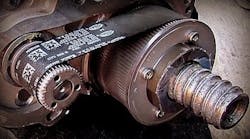Electronic Power Steering (EPS) is now standard equipment on virtually all new models of vehicles sold. One reason is clear: it removes the parasitic drag of the constantly turning, belt-driven hydraulic pump used to supply the hydraulic force to move the steering mechanism.
The current versions of the EPS system use an electric motor that only needs to apply steering assist when the steering wheel isn’t in the centered position. This on-demand type of EPS saves fuel and reduces emissions if the vehicle is equipped with an internal combustion engine (reducing the load on the alternator) and reduces the amount of electrical energy consumed if the vehicle is a hybrid or full electric. There are other EPS advantages that are often overlooked.
The EPS system lowers engine noises, power steering noises and vibrations that the common hydraulic power steering system would transmit into the passenger compartment. EPS also isolates the steering components from suspension vibration while still transmitting good road feel back to the driver. And it supplies speed-dependent steering control and enhanced safety. Honda, for example, has combined their Vehicle Stability Assist with the EPS system by increasing the steering wheel’s turning resistance if the driver reacts to a skid situation by turning the steering wheel in the wrong direction.
EPS isn’t new. It’s been involved in steering vehicles for some time now, but the current versions are far superior to their predecessors. They have exceptional road feel and response time, but that’s not all that these systems are capable of anymore. The current version of EPS when linked to the vast number of other vehicle systems can detect when the driver is not holding the steering wheel, and keep the vehicle driving in the desired direction providing autonomous or semi-autonomous driving, provide automatic parallel/perpendicular parking, offer lane-keep assist, automatic lane changes or bringing the vehicle out of its parking spot.
And these features are just the tip of what a fully incorporated EPS system can carry out when combined with other vehicles systems, cameras and sensors.
The system inputs
The EPS system works by calculating the amount of steering assist needed based on several factors and sensor inputs. But the most important EPS input sensors are the steering torque sensor and the steering angle sensor. These are crucial to the EPS system for proper functionality. Other sensor values such as yaw, vehicle speed, accelerometers, EPS motor rotation speed, EPS motor temperature and information from other vehicle systems are used but the steering torque and steering angle are the most essential.
The steering torque sensor measures and electronically reports the amount of torque that the steering wheel (via the driver) is applying to the steering shaft. This “turning torque” information is calculated by the torque sensor that measures the small amount of twist or torque in a specially designed torsion bar. This torsion bar will be found on the steering gear housing near the input shaft, or it could be incorporated into the steering column. The torque sensor assembly will be measuring the turning torque using a Hall-Effect sensor, a magnetoresistive pole wheel sensor or other electronic device. The torque sensor will measure and report the amount of twist in the steering shaft torsion bar. The EPS control module will receive this twist/torque information as an analog or digital signal and interpret it as a turning torque value. We can see this information on our scan tools as a lbs.-ft or Nm torque reading. The EPS module will use this torque sensor value to calculate the amount of steering assistance that the electric steering motor will need to apply.
The EPS system needs to know the steering wheel position and how fast the driver is turning the steering wheel, with information provided by the steering angle sensor. The steering angle sensor may be incorporated into the torque sensor assembly (late model GM), be a calculated value using the EPS motor position (Ford vehicles), incorporated into the clock spring (Dodge/Ram vehicles), or a stand-alone sensor mounted to the steering shaft (older GM models).
Steering angle sensors come in assorted designs that can incorporate inductive or Hall type sensor arrangements. Some vehicles will use a steering angle sensor that utilizes GMR (Giant Magnetoresistance) technology that supplies a 360-degree angle sensor output value. The GMR sensor can deliver complete multiple rotations steering angle values. The GMR output is derived from the orientation of the magnetic fields in the GMR steering angle sensor assembly.
The steering angle and steering wheel speed are important inputs for not only the EPS system but also to the stability system of the vehicle, so the information from this sensor is often shared over the vehicle’s communications network. The steering angle value is shown on our scan tools typically as a degree value and centering or zeroing the steering angle is a common service that needs to be performed after alignments and other repair services.
Most vehicles will be equipped with two torque sensors and two steering angle sensors for redundancy and safety. Using redundant sensors will limit the number of circumstances where a total loss of power steering could occur.
If there is a torque or steering angle sensor failure or malfunction, the EPS system will illuminate the EPS service light notifying the driver of an issue, but there may still be functional or partially functional power steering until repairs can be started.
The control system and the EPS motor
The EPS control module uses the information sent to it from the steering angle and torque sensors and from the vehicle’s communications networks to calculate the needed steering operation. Once the EPS control module has processed this data it will respond by controlling the current being applied to the EPS motor moving the steering gear to the desired position.
Most EPS systems use a 12-volt reversible permanent DC three-phase brushless electric motor for steering gear movement. The EPS motor will have an operating voltage of between 9V and 16V. This type of EPS motor is used because it provides the needed steering torque faster and more accurately when the EPS motor is spinning at a lower RPM. The EPS motor is controlled using a pulse-width modulated DC voltage signal.
Some Nissan Altima hybrids and GM hybrid trucks and SUVs use a DC-DC converter to step down the high voltage battery to supply 42V to the EPS systems. The EPS motor will supply feedback to the EPS module on its shaft location, motor rotational speed, motor temperature and its state of health.
EPS motor location is often related to vehicle size and packaging, and steering system design. Most larger vehicles (pickup trucks and SUVs) will have the EPS motor located directly on the steering rack and use a dual pinion or belt drive design for operation. Many smaller vehicles may have the EPS motor mounted to the steering column, inside the vehicle, to save space.
The EPS control module can detect and compensate for steering pull, steering nibble, road crown or heavy side winds by lessening the effect on the steering wheel, thus reducing driver fatigue. It can diminish bump steer, absorb rough road vibrations and aid in the centering of the steering wheel after a turn. It can also supply speed sensitive steering by reducing the steering assist at highway speeds and increasing it when doing slower parking lot maneuvers. The EPS control module may be equipped with software that will account for normal wear of the steering gear and EPS motor; this wear is compensated for by adding extra torque to keep the original steering feel. The 2022 Chevrolet Blazer system can even adjust the maximum steering gear travel and reduce the turning radius of the vehicle in a parking lot using an EPS control module system called Dynamic Rack Travel.
The EPS control module always needs to know the status of the EPS motor and its location related to its centered position (wheels straight) for proper steering control. The EPS control module will be constantly checking the power steering system looking for malfunctions, and if it detects any it will alert the driver with a dash warning light or message and set diagnostic trouble codes. The type of detected malfunction could limit the amount of power steering assistance available or in the worst case disable the steering assist entirely. If the EPS motor begins to overheat due to excessive high current demand, i.e. holding the steering wheel at lock for an excessively long time, the EPS control module will intervene. The EPS module will reduce the amount of current flowing to the EPS motor and lower the power steering assist temporarily, preventing damage to the involved components until the EPS motor temperature is reduced. The EPS control module will provide diagnostic service data on steering angle, torque sensor readings, EPS motor current draw, EPS motor temperature and many other pieces of data that can help a technician in diagnosing an EPS failure or complaint.
EPS services, warnings and notes
Steering angle centering/zeroing is one of the most common EPS service procedures that needs to be performed, and there are various methods that can be used. Centering or zeroing the steering angle sensor needs to be done after an alignment, steering component change, EPS module update, steering column repairs and after a dead or changed battery.
Many EPS systems will self-calibrate, usually by starting the engine and turning the steering wheel full lock-to-lock and then a short road test to supply a vehicle speed sensor input. This usually turns off the EPS warning lights and resets the system.
A scanner may be needed to reset the steering angle center value on some vehicles, but that may not be the only setting that will need to be reset if the steering angle value is cleared and reset. Many Toyotas need the yaw and acceleration sensors zero-point calibration to be performed after an alignment. Using an up-to-date information system will be the best source of knowledge when performing a steering angle sensor reset.
A note about service: when removing rotors and changing front end components, it is important to remember that the EPS motor may be directly attached to the steering rack and the hard blows of a hammer removing a stuck rotor, hub or tie rod end could damage the steering rack, the EPS motor, or other electronic components.
What’s next?
The electrification of the automotive fleet is happening now, so the use of an electronic power steering system will become the norm. The new GMC Hummer EV is equipped with two EPS steering assemblies: one on the front and one on the rear to enable the four-wheel steering and crab walk feature.
When the EPS system is integrated with on-board vehicle cameras and other vehicle sensor systems, vehicle features such as lane departure, lane correction and self-parking systems are standard equipment. But the integration of the EPS system isn’t going to stop there. The interest in semi-autonomous or fully autonomous driving by consumers and manufacturers is only going to make the EPS system a necessity in the near future.



